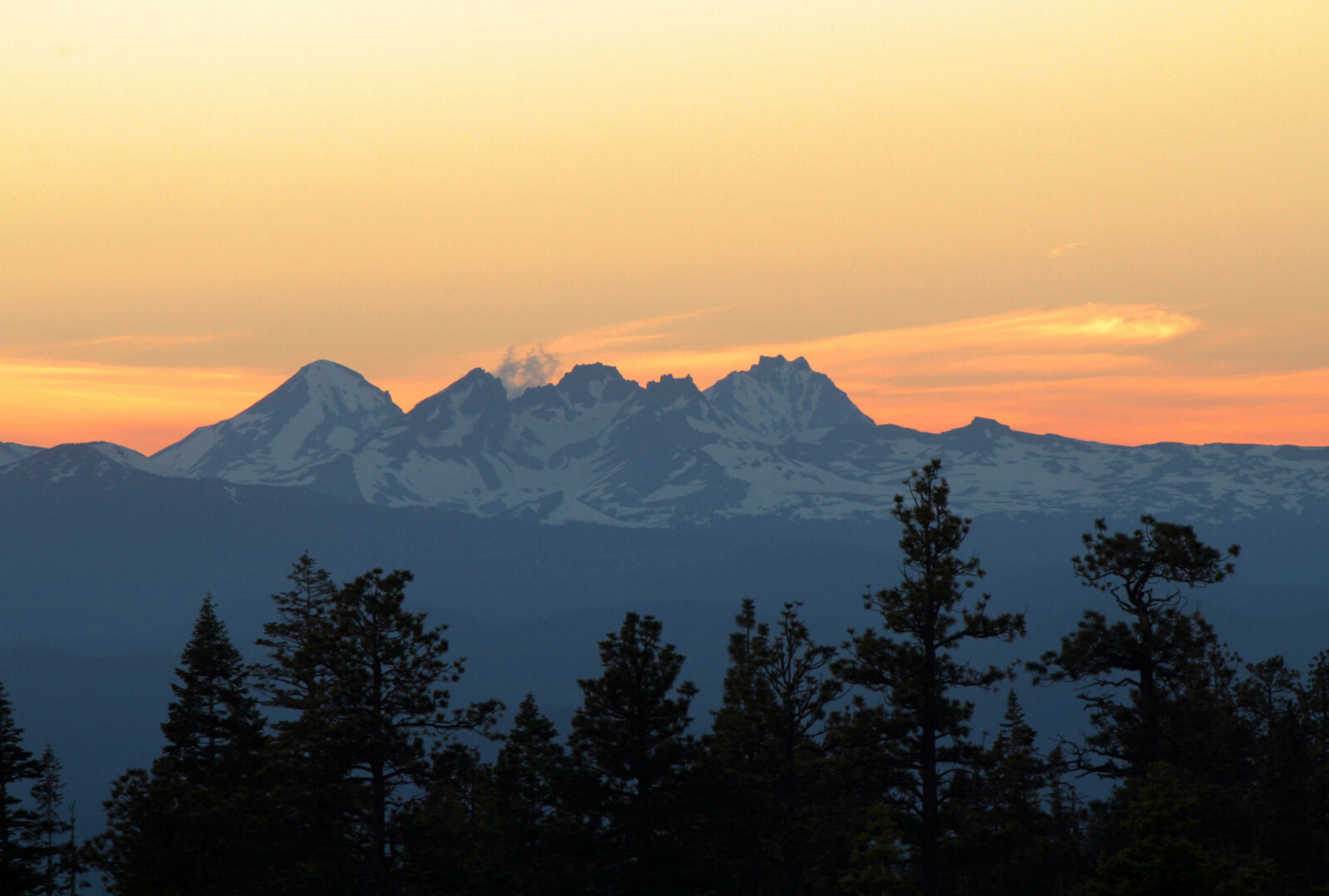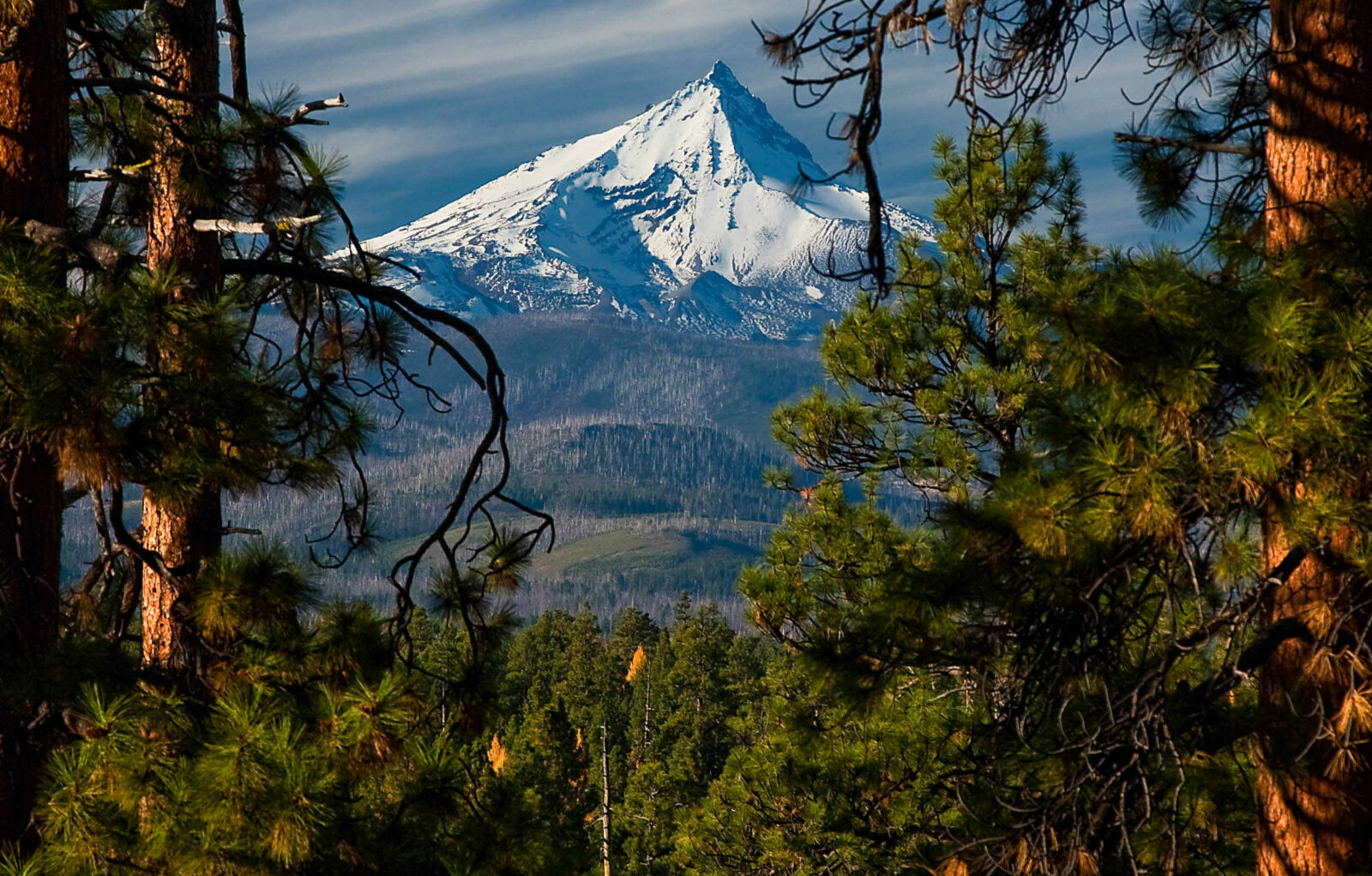Stark contrasts define the Deschutes National Forest in Central Oregon. Black lava fields are met by the shimmer of white snow fields, and glaciers rest atop volcanoes—joining the forces of fire and ice. A journey from east to west takes you from high desert to verdant forests. Old growth gnarled juniper forests of the arid eastern reaches transform to upright, slender lodgepole pines and ponderosas with their russet, puzzle-piece bark. The western boundary of the Deschutes National Forest is home to lush Douglas fir forests thick with green undergrowth. The Cascade Mountain Range stands guard over these landscapes, and omnipresent mountain views are reflected in clear alpine lakes that adorn the forests like jewels. Wild streams gain momentum on their trip downhill, forming rushing rivers that support diverse populations of fish and wildlife.
Two of these rivers in the Upper Deschutes River Basin, the Whychus and Metolius, are the focus of the National Forest Foundation’s (NFF) Treasured Landscapes conservation campaign, known locally as the “Tale of Two Rivers.” The Metolius River and Whychus Creek frame the small town of Sisters, Ore., my current home in the shadow of the Three Sisters Mountains.
On a recent trip to a local elementary one of my colleagues posed a question to the class. “What are the rivers that run through Sisters Country?”
She was astounded when the kids hesitated, racking their brains for the answer. A few students tentatively raised their hands, unsure of themselves, and named prominent Oregon rivers like the McKenzie and Deschutes. They couldn’t name the waters in their own backyards.
I’d like to say that as a child I was different. Growing up in nearby Bend, I wouldn’t have been interested in the Metolius River unless the MTV reality TV show “The Real World” came to film there or I could ferret out a pair of trendy jeans on the riverbank. I was just as guilty as the other sullen teenagers of my generation of spending copious amounts of time indoors and walking away from our National Forests.

Photo by Ken Homan
The "Three Sisters" of Deschutes National Forest.
For me, the cause of this gap came down to an underlying and ancient truth for teenagers: parents are not cool. By logical extension, the interests of my parents were similarly underwhelming. When my mom invited me on a hike, she was met by a resounding, “No, thank you!”
My dad couldn’t understand why I didn’t want to go scouting for the upcoming deer hunting season. The answer seemed simple to me—I would rather spend time with friends downtown than trudge around in the mud in an unflattering and boxy camouflage outfit.
This unbecoming and difficult phase ended abruptly when I discovered the second ubiquitous truth one learns in growing up: parents are almost always right. For me that realization was a vivid moment—I was releasing steelhead fry into one of our Central Oregon creeks with local nonprofit organizations, the Deschutes Land Trust and Upper Deschutes Watershed Coalition—now important local partners of the NFF.
For the first time I connected with the forests in a new way. I saw the story of the tiny fish was a mirror to my own story—the hope of swimming out to bigger waters and adventuring back stronger and wiser. I left Central Oregon after high school for the University of Puget Sound and came back in 2009 as a slightly bigger fish (due, in part, to gaining the unavoidable “freshman 15”) but also a much smarter one.
I also felt as if I had invested in something bigger than myself—joined a movement to revive what has come to be the icon of the Northwest—the salmon and steelhead. I wanted the little steelhead fry I had planted to come back and I was proud to be part of rewriting our local history.
My awakening to the beauty and spiritual benefits of our National Forests was an echo of the larger community’s trajectory toward sustainability. In Sisters, community members and leaders focused efforts on Whychus Creek and the Metolius River repairing habitat for wildlife and preparing it for the return of the lost anadromous fish in hopes the small fish they had planted would fight their way upstream.
For Whychus Creek, an important part of the restoration process was rediscovery. For thousands of years Native Americans had traced the course of Whychus Creek to the high country, the waters of the creek providing over half the steelhead spawning habitat in the Upper Deschutes River Basin. As homesteaders came to the Sisters area, the river lost its historic name and was called “Squaw Creek” to reflect this abundance of Native Americans. After losing its name, Whychus Creek lost its water to irrigation withdrawals and eventually lost its fish with the construction of hydroelectric dams downstream. It was relegated to a trickle of a creek in the summer and the pristine upper reaches of Whychus Creek were forgotten.

Mt. Jefferson on the Deschutes National Forest.
On the other hand, the Metolius River, like a favored daughter outshining a wilting sister, has drawn most of the attention of locals and visitors alike. The Metolius is a paradise for fly fishers and nature-lovers; thousands of sight-seers come to watch the crystal-clear water bubble up from underground at its headwaters. Due to this heavy recreational use, the well-loved Metolius River is in increasing need of care. As hikers, campers, and anglers trek to the waters of the Metolius River, they create new access points and user trails that attract more traffic. The banks of the river suffer from erosion, causing sediment that covers the important gravel beds that serve as important spawning habitat for fish. Because the water is spring-fed and remains at a somewhat gentle and steady flow year round, the Metolius River is extremely susceptible to this issue of sediment.
Local organizations and passionate advocates had already set the restoration in motion when the NFF selected the Metolius River and Whychus Creek as a Treasured Landscapes campaign site in 2008. The Deschutes River Conservancy and Oregon Water Trust had purchased water rights back from private owners and they kept that water in the creek— dramatically improving its water levels and beginning to enhance habitat for fish and wildlife. The creek began to retain water even at the height of summer, a faint trickle turning to a steady gurgle coming from Creekside Park in Sisters, where vacationers can see the creek run right through town. The reinvigorated creek replaced the dry, barren riverbed of the past.
The U.S. Forest Service Sisters Ranger District and others helped Whychus Creek get its historic name back. “Whychus” is a Native American word that means “where we cross the water,” and hearkens back to the time when local tribes would traverse the stream as they traded supplies, hunted game, and gathered food.
When the National Forest Foundation joined forces with local collaborative organizations that were actively restoring Whychus Creek and the Metolius River, it joined a strong community of supporters in Sisters. The town of Sisters is embedded in the Deschutes National Forest. The breathtaking mountain vistas and abundance of recreation benefit not only the local population, but the thousands of vacationers who come to bike, hike, camp, hunt, fish, and ski each year. The business-minded Sisters resident knows that our recreational assets add fuel to our local economy, creating a fertile environment for gourmet restaurants, art galleries, charming stores, and world-class events like our popular Sisters Rodeo, Sisters Outdoor Quilt Show, and Sisters Folk Festival.
To live in Sisters is to be connected to nature. Our landscapes and favorite places in the Deschutes National Forest propel our businesses, inspire our artists, and fill our weekends with outdoor activities. This explains why the NFF and U.S. Forest Service have been so successful in engaging non-traditional partners to support the watershed and upland habitat restoration efforts in Central Oregon.

A participant in the 2013 Plein Air Paint Out.
From cyclists at NFF’s second annual Ride for Two Rivers, to the beer-lovers that enjoyed the “Water of Life Ale” at the local microbrewery, Three Creeks Brewing Co., diverse crowds have turned out to provide enthusiastic support for the “Tale of Two Rivers.” Artists from around the state and beyond have enjoyed our 3rd annual Plein Air “Paint Out,” a timed painting competition at selected sites essential to the restoration of Whychus and Metolius watersheds. Artistic work resulting from the Paint Out have been displayed in art shows that help provide a platform for educational outreach about the NFF’s restoration projects; photos of winning pieces have been used in environmental reports, presentations, and outreach pieces. The art is truly worth a thousand words, helping to communicate the beauty and value of our local landscapes.
New in 2012, quilters will throw a stitch in to the “Tale of Two Rivers” efforts, quilting a collaborative exhibit that highlights the dynamic Whychus Creek. Quilts will hang at the Sisters Outdoor Quilt Show—the largest outdoor quilt show in the world that draws over 10,000 visitors each year—and half the proceeds from the sale of each quilt will directly support on-the-ground efforts to restore the Whychus and Metolius Rivers.
These on-the-ground restoration efforts since the site was chosen as a Treasured Landscape have been significant. Thus far we have worked to address local restoration priorities, including the naturalization of 2 miles of trails that trample sensitive riparian zones and cause harmful erosion, the creation or improvement of 11 miles of trails that help visitors enjoy the watersheds in a healthier manner, the eradication of invasive weeds on about 20 acres, the restoration of 8 acres of riparian areas within the watersheds, and the planting of 950 trees and shrubs along the banks of the Whychus and Metolius.
As she searched the streambed for redds and signs of fish, I saw in her the very transformational spark that ignited my love affair with the outdoors.
The NFF and partners have helped to engage over 400 volunteers in achieving these conservation projects at our Friends of the Forest® volunteer work days near Sisters. These volunteers have donated over 1,700 hours, contributing an estimated $31,900 worth of their time. More than this, the volunteers have learned more about the complex contemporary challenges our National Forests face, and personally invested in the health of our public lands as stewards.
In working as the Sisters Volunteer Bank Coordinator for the National Forest Foundation, helping to sustain these collaborations and organize volunteers for events and conservation projects, the most rewarding moment came when I organized a Friends of the Forest Day volunteer event with the local Sisters High School.
A biology class came out on Earth Day 2011 to plant trees on the banks of Whychus Creek. One young girl, apprehensively kicking the dirt, whispered to her friend, “What’s the big deal about these fish?” As she got her hands dirty with her friends and chatted with local scientists, it was clear she began to see the big picture—began to join the community dreaming of the days its vibrant fish return from the sea. As she searched the streambed for redds and signs of fish, I saw in her the very transformational spark that ignited my love affair with the outdoors.
The first salmon just returned to the Pelton Fish Trap on its way to our Central Oregon rivers, and the community is buzzing with excitement. The smolt’s return is a poignant reassurance that the next chapters in the “Tale of Two Rivers” will be stories of revival. In the dynamic region of Central Oregon—a land of fire and ice—we hope to make the starkest contrast of all: the disparity between the current condition of our rivers and their future restored and healthy state, with ecosystems restored and anadromous fish returning home to spawn. I’m happy to be part of that legacy.

